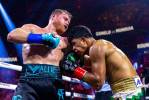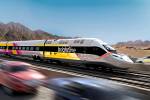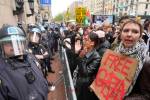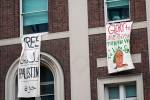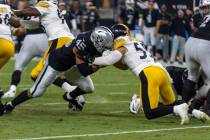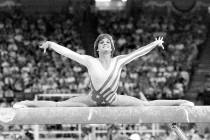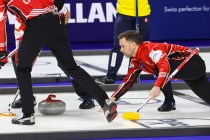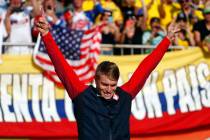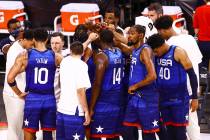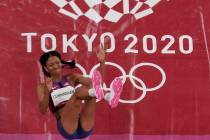CHINESE MOVE PAST MEMORIES OF MASSACRE


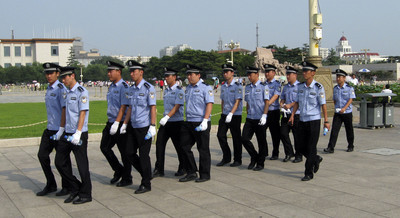
BEIJING — He is difficult to distinguish now as cars rush by and tourists herd between one side of the street and the other. They were eager to chase the prospect of a better life back then, too. People forget that part. Massacres tend to have that affect.
Governments can’t suppress images when you close your eyes and remember what the world saw. He was right there, right in the middle of Chang’an Avenue, the small figure of a courageous man in a white shirt who would reach international fame and never be seen again. The symbol of idealism. The spirit of a society’s conscience.
Tank Man.
Want irony?
This is in part why they protested, the idea of a welcoming and animate space, alive with the hope that they might one day know a China willing to allow its people the opportunity at democratic and economic prosperity. This is, in one way, what all the blood and horror at Tiananmen Square was about.
The democracy part hasn’t happened, but you need only stroll a few feet around the world’s largest square to realize China is far more Western than that terrifying time in 1989, when students and activists and scholars peacefully demonstrated for seven weeks against the totalitarianism and economic policies of the ruling Communist Party. It ended with hundreds and perhaps thousands being crushed by military tanks or shot dead by army guns.
You wouldn’t know that now.
Images are all we have.
***
The square is massive, both in size — are you ready to walk the entire 4.7 million square feet? — and rejection of anything that might generate discussion of that turbulent time. Kids skateboard here. Toddlers crawl across concrete slabs. Tour buses slowly roll in, one after another, filled with people who don’t really know what to look for but certain they must try.
Police cars sit in the center of the square. Soldiers stand guard. Vendors hawk disposable cameras. Citizens wearing "I Love China" T-shirts travel upward of 11 hours by train to walk the grounds. There is laughter, joy, hope, pride.
"I think a lot of the Chinese you see here don’t know what happened before," said Helen Coachman, who left her home in Wales more than two years ago to live in Beijing while producing a book of art on the workers who built Olympic venues. "To them, it’s about national pride, like we would go to any big squares in our countries and celebrate and take pictures.
"The government doesn’t talk (about 1989). The media doesn’t cover it. I just don’t think people now know much about it."
The Chinese instead want you to know about the Tiananmen of today, the one of grandeur and delight. Mao Zedong proclaimed the Communist Republic of China in 1949 at the square and his tomb now stands on the south end, where people line up daily to stroll past his preserved body in a glass coffin.
Yeah, even that remains a big deal.
There are monuments and bright flowers and flags and art exhibits and a national museum. There is a Porsche dealership within a stone’s throw. This is the emblematic heart of China, and it beats only for its future now.
That’s on the outside.
Inside, you wonder how Ling Hao would have felt in 1989. He is a 23-year-old student from Suzhou, a city on the lower portion of the Yangtze River and part of the Jiangsu Province. Today, he takes pictures and talks of his favorite American athlete (Kobe Bryant) and speaks of the square and the adjoining Forbidden City in a far more reverent than contentious way.
Students in China have seemingly forever been linked to voicing how its principles should be shaped. Never was this more evident than in 1989, when they were willing to die for future generations so that theirs might be a nation free of corruption.
"No, no, no, no," Ling said when asked about 1989. "China about future, not about past. This is a very serious and beautiful place. It is the center of our capital. Very serious. Very beautiful."
***
He stood alone in the road that day as the tanks approached, the anonymous face who would define millions. He waved two bags in the air as if to motion the threat away, like you might an agitated wasp. The tanks turned one way and he moved to block them. They turned again. He moved again.
He would climb on top of the lead tank and speak with the driver. He is believed to have asked the soldiers to leave the city, that any military presence was not wanted. Others then pulled the man away and into the crowded square, and the theory goes police eventually executed him. Tank Man. The Unknown Rebel.
It remains the image we have of a Tiananmen Square from a more chaotic and bloody time.
You wouldn’t know that now.
Ed Graney is the Review-Journal’s sports columnist. He can be reached at 383-4618 or egraney@reviewjournal.com.
ON THE WEB View the slideshow


